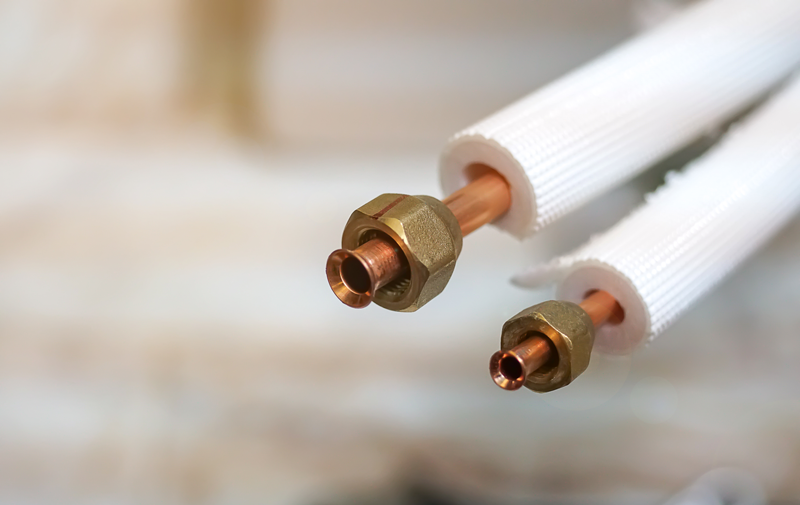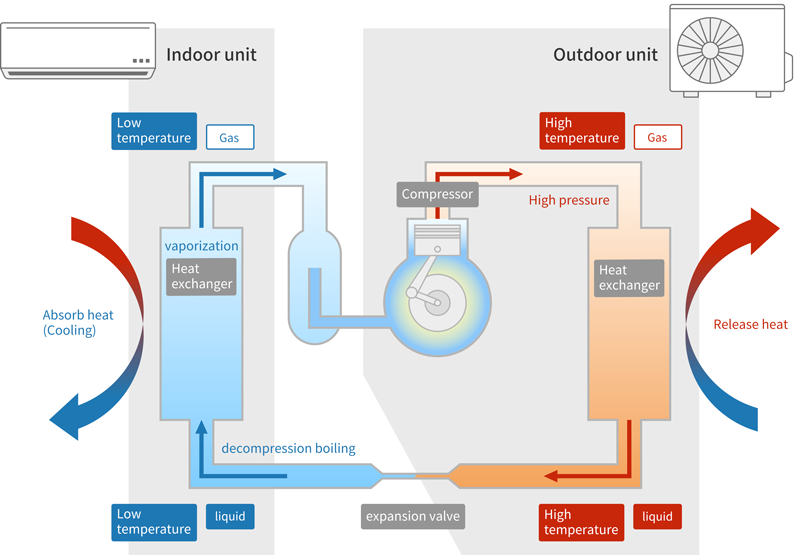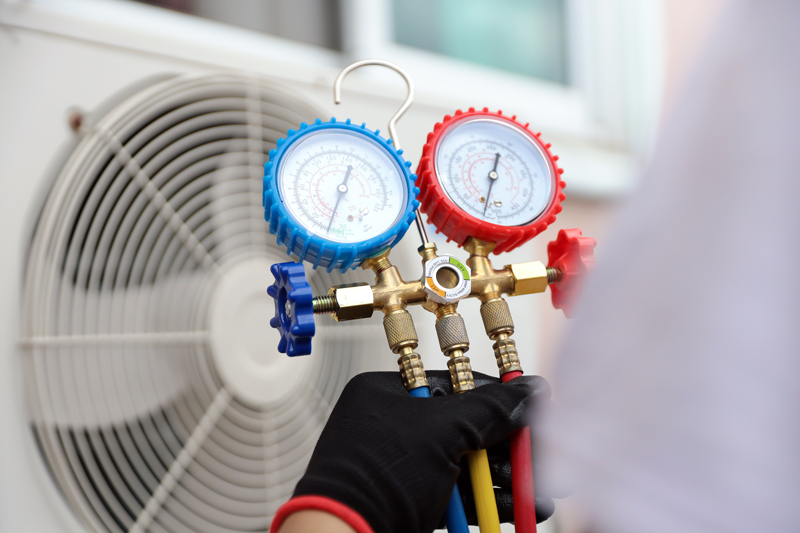Air conditioners have become an essential part of modern life, providing comfort by regulating indoor temperature and humidity. But how exactly do they control room temperature? The answer lies in a special substance called refrigerant, which plays a crucial role.
What kind of machine is an air conditioner, and how does it function , and what exactly is the refrigerant that supports its function? In this article, we will explore the basic mechanism behind air conditioners, and uncover the vital role refrigerants play in indoor climate control.
Index
What is an air conditioner?
An air conditioner, abbreviated as A/C, is a device used to adjust the indoor air to a comfortable temperature and humidity.
A person's perceived temperature is greatly influenced by the indoor temperature and humidity. By controlling these factors, air conditioners help create a cool environment in the summer and a warm one in the winter. Today, air conditioners are indispensable equipment, playing a vital role in ensuring comfortable living environment and managing health.
The main units and their roles in an air conditioner
An air conditioner is mainly composed of three units: the indoor unit, the outdoor unit, and the pair coil that connects them.
- The indoor unit

The indoor unit is a device that draws in air from the room, cools or heats it, and then circulates it back into the room. It contains a component called a heat exchanger through which a substance known as refrigerant flows. This refrigerant cools or warms the air to adjust the room temperature. Since refrigerant is one of the most important elements of an air conditioner, its role will be discussed in detail in a separate section.
- The outdoor unit

The outdoor unit is responsible for releasing the heat or cold absorbed by the refrigerant indoors to the outside. Its key components are the compressor and the heat exchanger. The compressor is used to compress the refrigerant during cooling. Details about the cooling mechanism will be explained in a later section. To improve heat dissipation efficiency, the outdoor unit is also equipped with a fan. Since the unit is exposed to external environments, it is important to keep the surrounding area clear of debris and obstructions.

The pair coil is the piping that connects the indoor and the outdoor units. Through this piping, refrigerant circulates between the indoor and outdoor units, adjusting the temperature inside.
Cooling and heating
Air conditioners have two functions: cooling and heating.
During cooling operation, the system lowers the room temperature by transferring indoor heat to the refrigerant and releasing that heat outside. In contrast, during heating operation, the system absorbs outdoor heat into the refrigerant, compresses it to raise its temperature, and then sends it indoors to warm the room. Therefore, while both functions use the same piping and units, the direction of refrigerant flow and the orientation of heat absorption and release are reversed.
The next section explains how air conditioners adjust room temperature, using the cooling function as an example.
The mechanism and principles of cooling
The cooling function of an air conditioner operates by utilizing the heat-transfer properties of refrigerant. This section provides a brief overview of how the process works.

When an air conditioner operates in cooling mode, the refrigerant sent to the indoor unit is cooled and liquefied. As indoor air is drawn into the unit, it comes into contact with the heat exchanger that has been cooled by the refrigerant. The air is cooled and then sent back into the room, lowering the room temperature.
The refrigerant that has absorbed indoor heat changes from liquid to gas and is sent to the outdoor unit through the pair coil. Once, taken into the outdoor unit, the compressor compresses the refrigerant into a high-temperature, high-pressure gas.
This gas, then passes through the outdoor heat exchanger, where it releases the absorbed heat to the outside air.
After releasing its heat, the refrigerant turns back into liquid and is sent back to the indoor unit. By continuously circulating this cycle, the indoor air is cooled.
As introduced so far, the refrigerant plays a very important role in air conditioning. In the next section, we will delve deeper into the topic of refrigerants.
What is refrigerant?
Refrigerant is a substance used to transfer heat by repeatedly changing between liquid and gas states. To smoothly handle the cycle of heat absorption and release, compounds that easily vaporize and can withstand compression are used. Commonly used refrigerants are fluorocarbon compounds. However, due to concerns about ozone layer depletion and global warming, there has been active movement to reconsider their use. In recent years, new environmentally friendly refrigerants have been researched and developed.
Types of refrigerants
In the early days of air conditioning, chlorofluorocarbons (CFCs) were used as refrigerants. However, once it was discovered that CFCs have properties that destroy the ozone layer, the development of safer refrigerants began. Today, hydrofluorocarbons (HFCs) are the mainstream choice. While HFCs do not pose a threat to the ozone layer, they still have high global warming potential. Currently, the focus has shifted toward the development of refrigerants with lower global warming effects than HFCs, with hydrofluoroolefins (HFOs) and natural refrigerants like R290 (propane) receiving particular attention.
The risks of refrigerant leakage

As mentioned in the previous section, refrigerants are substances that contribute to global warming. Additionally, many of the currently used refrigerants, such as HFCs, are flammable. Therefore, refrigerant leakage entails significant risks from both environmental and safety perspectives.
What happens if the air conditioner's refrigerant leaks?
If the refrigerant circulating between the indoor unit and the outdoor unit is insufficient, the air conditioner's cooling capacity decreases. This can lead to ineffective temperature and humidity control, resulting in discomfort, and in some cases, overheating and malfunctioning of the air conditioner. Additionally, the release of fluorocarbon refrigerants into the atmosphere can contribute to global warming and ozone layer depletion. For flammable refrigerants like HFCs, leakage also poses a fire hazard. To prevent these issues, regular inspections and maintenance to detect abnormalities are crucial.
Refrigerant leakage alarm and sensors
To quickly detect refrigerant leaks, leakage alarms are increasingly being installed in large-scale air conditioning systems in commercial facilities and factories. The larger the scale, the greater the total amount of refrigerant, which means the environmental impact and health risks in the event of an accident are also greater.
Additionally, due to amendments to regulations concerning air conditioning equipment in the 2010s, leak detection has been mandated not only for large-scale installations but also for household air conditioning equipment. These regulatory changes have been advanced not only in Japan but also in international standards such as the IEC. Consequently, the importance of sensors to detect refrigerant leaks has grown significantly within the air conditioning industry.
The necessity of refrigerant sensors
Refrigerant sensors are devices installed within air conditioning systems to detect small leaks and notify of any abnormalities. In case of a major refrigerant leak, there are not only environmental destruction impacts but also risks of fire and explosion. Implementing refrigerant sensors capable of detecting minor leaks can prevent major troubles and skyrocketing repair costs. As mentioned earlier, it is now mandatory to incorporate refrigerant sensors into air conditioning equipment. They have become essential components that must be considered in the development of air conditioning systems.
Nissha FIS refrigerant leak detection sensor

Nissha FIS provides refrigerant leak detection sensors suitable for integration into air conditioning equipment. These sensors comply with the international standard for air conditioning equipment, IEC60335-2-40 Ed.7 ANNEX LL, and have shipped over one million units in the past decade.
The sensors feature high durability with a lifespan of over 10 years and include built-in filters to eliminate the effects of interfering gases. They are compact and lightweight, with models available for both indoor and outdoor units.
If you are considering incorporating sensors into your air conditioner design, please visit our product introduction page.
(Go to our product page)


